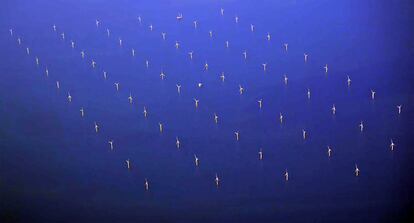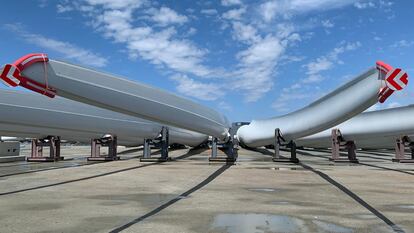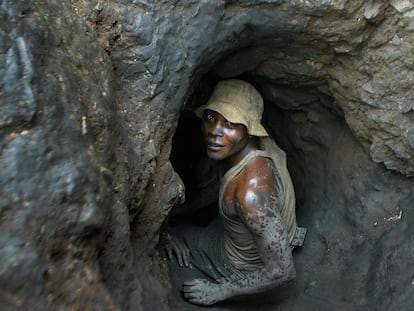From oil to wind: this is how the North Sea has transformed into Europe’s energy hub
The EU has placed a large part of its hopes for decarbonization and strategic energy independence on wind farms. Of all member states, Denmark is in the lead: by 2030, the Scandinavian country’s energy production from wind turbines will exceed national demand


Oil is dead: long live wind power!
The North Sea – modest in size, but gigantic in economic importance – washes up against the wealthy coasts of Europe. This body of water is currently immersed in an accelerated transition towards its second energy life.
In the 1970s, 1980s and 1990s, oil and gas reserves bolstered the already-fertile economies of Denmark, the Netherlands, the United Kingdom and – above all – Norway. But these fossil fuels have more of a past than a present. Today, the future is not under the water, but on it – and it runs on the sound of the wind. The 27 EU member states have made an unprecedented commitment to developing wind energy. Their goals of decarbonization and energy independence depend on the success of this source of power.
Whatever fossil fuels companies say, oil and gas will likely be fossils much sooner than many can – or want – to imagine. The world of energy is changing by leaps and bounds… especially in Europe since the Russian invasion of Ukraine, which has exposed the stark risks of being dependent on resources over which EU nations have no control.
Denmark is a country of barely six million inhabitants, living on less than 16,000 square miles of land. The small nation is also prosperous, with a per-capita income of more than $70,000 – double that of a Western European nation such as Spain. Denmark – a witness to the recent accelerated energy shift – sees no return to the past. The Scandinavian nation wants to move away from oil and gas exploration and production towards a greener future.

“We want to be a great source of green electricity for the whole of Europe,” said Dan Jørgensen – the Danish minister for climate and energy – in the early stages of the crisis caused by Vladimir Putin. Just two decades after the inauguration of its first offshore wind farm – then a rarity – Denmark now leads the wind energy market, alongside neighboring Sweden and Norway. Danish citizens are well-aware of the climate issue – in polls, global warming repeatedly appears at the top of citizen concerns. The public is convinced that the time has come to take a big step forward. And not only does the country want to meet its own needs with green energy: the ultimate goal is to become the great battery that powers the EU.
The Danish plans are of a magnitude that is difficult to imagine in Europe. In countries such as Spain, very deep waters are just a short distance from the coast, preventing the fixing of windmills into the seabed. But in Denmark, this problem doesn’t exist. In the North Sea, the depth of the water is low, while the gusts of wind are powerful and prolonged. It’s the perfect breeding ground for a technology that has not reached its maturity level yet, but is already yielding remarkable rates of energy production. This is just the start of what’s to come: the country’s roadmap involves tripling the current capacity by 2030.
By the end of this decade, offshore wind generation will already exceed the domestic demand for electricity by 40%, while the country’s total energy usage will already be fully based on renewables. The surplus will be sold to the rest of Europe. Denmark is in a great geographic position for this, as the Scandinavian country is just a step away from Germany – by far the largest energy consumer in the EU – and the Netherlands and Belgium. The business possibilities that arise thanks to this green energy surplus are simply huge. By 2050, wind turbines in the North Sea will reach their peak… and not only in Denmark. The eight EU countries with access to the body of water – along with the United Kingdom – will have enough wind turbines installed to generate sufficient electricity to cover the needs of 300 million households each year.
Gray and nondescript, the port of Esbjerg – three hours by train west of Copenhagen – is a representative image of the energy and economic shift that the continent is undergoing. Its docks – dedicated to fishing since time immemorial – eventually came to be dominated by the auxiliary ships of the oil and gas platforms. Today – as EL PAÍS was able to verify this week, in a visit organized by the European Commission – another transformation is underway: the vast majority of cargo ships are transporting material for the construction of dozens of wind turbines, which will be installed just a few miles offshore.
A few feet from the docks, dozens of blades and wind turbines lie on the ground, ready to be installed. And, a little further inland, there are huge warehouses and workplaces, which belong to a good number of companies that are closely linked to the offshore wind industry. Among them are the generator manufacturers Vestas (Danish) and Siemens Gamesa (of Spanish origin, now in German hands); the engineering firm Semco Maritime – a name historically linked to crude oil, but now seeing more business in wind – and the largest Scandinavian electric company, the Swedish state-owned Vattenfall. All of them are aware of the size of the pie that is about to be cut up in the coming years… and nobody wants to leave the party without their piece.

Paul Erik Jacobsen – a stocky, blue-eyed man in his sixties, with a weathered face – had to leave his job at Maersk Oil (now named TotalEnergies) a little over five years ago, when the Danish fossil fuel sector had already begun its inexorable decline. Highly knowledgeable about the ins and outs of the port of Esbjerg, he landed on his feet on the other side of the increasingly porous barrier between fossil fuels and renewables. “For me, it means working on something with a future,” he notes, his voice echoing in the gigantic industrial warehouse where he’s now the boss. This career shift is by no means unique: half-a-century ago, fishermen found work in the then-dazzling oil industry. Today, oil workers are now transitioning from dirty to clean energy. This is the blue-collar version of a trend that has already been taking place for years among the great engineers of the energy world.
All energy sources are insufficient for what Europe will need in the coming years. The combined whirlwind of the climate emergency and the Russian invasion of Ukraine is making it clear that the continent needs to transition – at full speed – to a completely different energy matrix from the current one. The alternative should be emissions-free and insulated from the always-turbulent geopolitical panorama.
Natural gas and coal will have to rapidly exit the electricity market to reduce the still-heavy burden of emissions. The EU’s cars will soon shift to battery power: by 2035, across the 27 member states, it will no longer be possible to sell cars that have combustion engines. All processes that can be electrified will be switched over. And, as economic growth and energy consumption rise, the continent will need many more terawatt hours to cover its needs. The exit from this labyrinth can be found in the winds of the North Sea (and perhaps in the sun of the Iberian Peninsula, which is dominating the solar panel industry).
With two energy islands, Denmark looks to the future
The plan to feed energy to the old continent from the North Sea has a powerfully futuristic taste… especially when it comes to the creation of so-called “energy islands.” Discreetly, in the midst of a pandemic – when the virus had the entire world’s attention – the Danish Parliament approved the creation of two energy islands, from which to store the energy generated by offshore wind farms. Of the 179 members of the legislature, only half-a-dozen votes were cast against this proposal – energy security is clearly a nonpartisan issue in Denmark. If nothing goes wrong, both energy settlements will become reality by the end of this decade.
The first will be located on the natural island of Bornholm – with a population of 40,000 – in the Baltic Sea. This site will make for an efficient concentration of all the electrical production generated by the wind turbines, directing it towards Denmark, as well as to the German coasts. The second project is even more ambitious: it involves creating an artificial island out of nothing, about 60 miles west of the Jutland peninsula, in the middle of the North Sea. The design of the latter is still unknown, but sources close to the project suggest that it will most likely be built in a similar fashion to oil platforms: with a lot of metal and pragmatism, above all else.
In the short-term, both islands will centralize the hundreds of miles of cables from the offshore wind farms, to then merge them into a single line towards their destination. In the long run – as early as the 2030s – the islands will also house electrolyzers, to generate green hydrogen and green fuels on-site. “The logic lies – above all – in reducing the distance between the wind turbines and the Danish coast,” Hanne Storm Edlefsen tells EL PAÍS. She is the vice president of Energinet, the publicly-owned company that manages the Danish electrical grid. “The further away they are and the more installed power there is, the more sense it makes. The idea fits perfectly with our ambition to turn Denmark into one of the great energy hubs of Europe: we have a lot of wind, and this will allow us to generate very cheap electricity.”
Although they are pioneers, the Danes will not have the only energy islands in Europe. Germany – which is participating in the financing of the project of its northern neighbor, knowing that it will be one of its main beneficiaries – also has similar plans, as do Belgium and the Netherlands. The goal is to ultimately chain all of these islands together, with a network of cables that would operate as a kind of parallel interconnection. Based hundreds of miles off the coast, this would facilitate the two-way transfer of electrons.
“The more interconnected we are, the better for everyone: consumers will pay lower prices and more renewable [energy] generation can be integrated,” Edlefsen concludes. Spain and Portugal – two countries eternally disconnected from the rest of the continent when it comes to energy – know how harmful the alternative to unity can be.
Sign up for our weekly newsletter to get more English-language news coverage from EL PAÍS USA Edition
Tu suscripción se está usando en otro dispositivo
¿Quieres añadir otro usuario a tu suscripción?
Si continúas leyendo en este dispositivo, no se podrá leer en el otro.
FlechaTu suscripción se está usando en otro dispositivo y solo puedes acceder a EL PAÍS desde un dispositivo a la vez.
Si quieres compartir tu cuenta, cambia tu suscripción a la modalidad Premium, así podrás añadir otro usuario. Cada uno accederá con su propia cuenta de email, lo que os permitirá personalizar vuestra experiencia en EL PAÍS.
¿Tienes una suscripción de empresa? Accede aquí para contratar más cuentas.
En el caso de no saber quién está usando tu cuenta, te recomendamos cambiar tu contraseña aquí.
Si decides continuar compartiendo tu cuenta, este mensaje se mostrará en tu dispositivo y en el de la otra persona que está usando tu cuenta de forma indefinida, afectando a tu experiencia de lectura. Puedes consultar aquí los términos y condiciones de la suscripción digital.
More information
Últimas noticias
Tiger Woods turns 50: Will he continue playing on the PGA Tour or take a back seat?
The surreal journey of James Nnaji, the Barcelona youth player selected in the NBA Draft who ended up in the NCAA
Trump claims peace in Ukraine is near, but Moscow suggests otherwise
A survivor’s account of the Interoceanic Train accident: ‘We were scared because of the speed on the curve’
Most viewed
- Oona Chaplin: ‘I told James Cameron that I was living in a treehouse and starting a permaculture project with a friend’
- Reinhard Genzel, Nobel laureate in physics: ‘One-minute videos will never give you the truth’
- Why the price of coffee has skyrocketed: from Brazilian plantations to specialty coffee houses
- Pablo Escobar’s hippos: A serious environmental problem, 40 years on
- Chevy Chase, the beloved comedian who was a monster off camera: ‘Not everyone hated him, just the people who’ve worked with him’










































